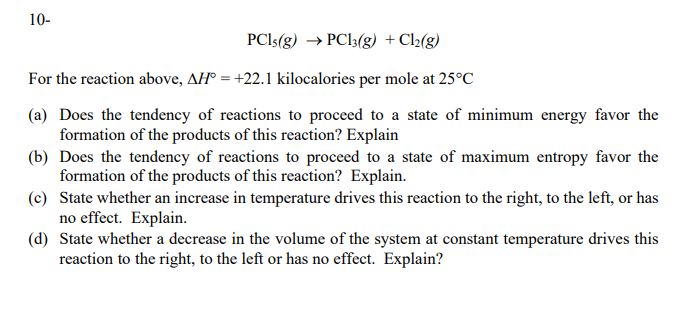10- PCI5(g) → PCI3(g) +Cl2{g) For the reaction above, AH° = +22.1 kilocalories per mole at 25°C (a) Does the tendency of reactions to proceed to a state of minimum energy favor the formation of the products of this reaction? Explain (b) Does the tendency of reactions to proceed to a state of maximum entropy favor the formation of the products of this reaction? Explain. (c) State whether an increase in temperature drives this reaction to the right, to the left, or has no effect. Explain.
10- PCI5(g) → PCI3(g) +Cl2{g) For the reaction above, AH° = +22.1 kilocalories per mole at 25°C (a) Does the tendency of reactions to proceed to a state of minimum energy favor the formation of the products of this reaction? Explain (b) Does the tendency of reactions to proceed to a state of maximum entropy favor the formation of the products of this reaction? Explain. (c) State whether an increase in temperature drives this reaction to the right, to the left, or has no effect. Explain.
General Chemistry - Standalone book (MindTap Course List)
11th Edition
ISBN:9781305580343
Author:Steven D. Gammon, Ebbing, Darrell Ebbing, Steven D., Darrell; Gammon, Darrell Ebbing; Steven D. Gammon, Darrell D.; Gammon, Ebbing; Steven D. Gammon; Darrell
Publisher:Steven D. Gammon, Ebbing, Darrell Ebbing, Steven D., Darrell; Gammon, Darrell Ebbing; Steven D. Gammon, Darrell D.; Gammon, Ebbing; Steven D. Gammon; Darrell
Chapter18: Thermodynamics And Equilibrium
Section: Chapter Questions
Problem 18.93QP: For the decomposition of formic acid, HCOOH(l)H2O(l)+CO(g) H = +29 kJ/mol at 25C. a Does the...
Related questions
Question

Transcribed Image Text:10-
PCI5(g) → PCI3(g) +Cl2{g)
For the reaction above, AH° = +22.1 kilocalories per mole at 25°C
(a) Does the tendency of reactions to proceed to a state of minimum energy favor the
formation of the products of this reaction? Explain
(b) Does the tendency of reactions to proceed to a state of maximum entropy favor the
formation of the products of this reaction? Explain.
(c) State whether an increase in temperature drives this reaction to the right, to the left, or has
no effect. Explain.
(d) State whether a decrease in the volume of the system at constant temperature drives this
reaction to the right, to the left or has no effect. Explain?
Expert Solution
This question has been solved!
Explore an expertly crafted, step-by-step solution for a thorough understanding of key concepts.
This is a popular solution!
Trending now
This is a popular solution!
Step by step
Solved in 2 steps

Knowledge Booster
Learn more about
Need a deep-dive on the concept behind this application? Look no further. Learn more about this topic, chemistry and related others by exploring similar questions and additional content below.Recommended textbooks for you

General Chemistry - Standalone book (MindTap Cour…
Chemistry
ISBN:
9781305580343
Author:
Steven D. Gammon, Ebbing, Darrell Ebbing, Steven D., Darrell; Gammon, Darrell Ebbing; Steven D. Gammon, Darrell D.; Gammon, Ebbing; Steven D. Gammon; Darrell
Publisher:
Cengage Learning

Chemistry & Chemical Reactivity
Chemistry
ISBN:
9781337399074
Author:
John C. Kotz, Paul M. Treichel, John Townsend, David Treichel
Publisher:
Cengage Learning

Chemistry & Chemical Reactivity
Chemistry
ISBN:
9781133949640
Author:
John C. Kotz, Paul M. Treichel, John Townsend, David Treichel
Publisher:
Cengage Learning

General Chemistry - Standalone book (MindTap Cour…
Chemistry
ISBN:
9781305580343
Author:
Steven D. Gammon, Ebbing, Darrell Ebbing, Steven D., Darrell; Gammon, Darrell Ebbing; Steven D. Gammon, Darrell D.; Gammon, Ebbing; Steven D. Gammon; Darrell
Publisher:
Cengage Learning

Chemistry & Chemical Reactivity
Chemistry
ISBN:
9781337399074
Author:
John C. Kotz, Paul M. Treichel, John Townsend, David Treichel
Publisher:
Cengage Learning

Chemistry & Chemical Reactivity
Chemistry
ISBN:
9781133949640
Author:
John C. Kotz, Paul M. Treichel, John Townsend, David Treichel
Publisher:
Cengage Learning


Chemistry
Chemistry
ISBN:
9781305957404
Author:
Steven S. Zumdahl, Susan A. Zumdahl, Donald J. DeCoste
Publisher:
Cengage Learning

Chemistry: An Atoms First Approach
Chemistry
ISBN:
9781305079243
Author:
Steven S. Zumdahl, Susan A. Zumdahl
Publisher:
Cengage Learning